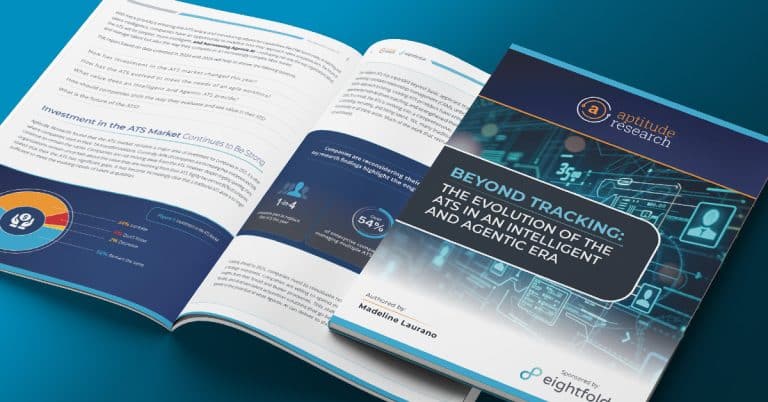
Beyond tracking: The evolution of the ATS in an intelligent and agentic era
Beyond tracking: The evolution of the ATS in an intelligent and agentic era
The Applicant Tracking System (ATS) has long been a cornerstone of the talent acquisition tech stack, yet many organizations find current systems lacking in functionality and flexibility.
Historically viewed as a tool for compliance and managing applicant workflows, the traditional ATS is no longer sufficient to meet the demands of a dynamic and competitive talent market. As businesses undergo change and candidate expectations evolve, a significant shift is occurring in how organizations select, assess, and use the ATS.
This Aptitude Research report explores the evolution of the ATS, highlighting the move from a reactive data repository to a proactive, intelligent system that drives strategic talent acquisition. And why now is the time for organizations to move on to a more dynamic system that can respond to today’s pace of change.
Download the full report to learn:
- Why only 28% of companies are satisfied with a current ATS, with a quarter planning to replace this system in 2025.
- How the role of the ATS is evolving from a passive data-storage tool to an intelligent system for active candidate engagement and talent rediscovery.
- What the key feature gaps are in traditional ATS platforms, including scheduling (48%), analytics (36%), and sourcing (30%).
The Applicant Tracking System (ATS) has long been a cornerstone of the TA tech stack. Historically, companies viewed this as a necessary evil, something that would only serve as a compliance tool or an applicant workflow. The ATS market has evolved quite a bit over the past decade, yet its traditional role has been largely static and focused on processing applications rather than keeping pace with the fluid and dynamic nature of the talent market. Today, as companies struggle with transformation, changing candidate expectations, and evolving business needs, the way organizations buy, evaluate, and use their ATS must shift.
Historically, companies face two primary options when selecting an ATS: either remain with an outdated system that failed to meet user expectations or invest in a new solution. However, when investing in a new system, buyers had been forced to choose between their integrated HCM provider or to opt for a best-of-breed solution that offered “better” functionality and innovation. This trade-off between integration and functionality left many companies dissatisfied. Aptitude Research found that only 28% are currently satisfied with their ATS decisions.
The ATS itself is not becoming obsolete. Rather, it has evolved beyond a basic workflow tool. But companies still face frustrations and gaps in what the ATS has promised it could and should do. The future of ATS lies in its ability to deliver greater strategic value — moving beyond process automation to incorporate talent intelligence, AI-driven insights, and deeper candidate engagement. Agentic AI is helping to make this evolution a reality. Organizations can no longer view the ATS as a workflow engine but instead as a dynamic component of a broader, more intelligent talent strategy.
Currently, 1 in 4 companies are replacing their ATS in 2025. To realize the full potential of an ATS, companies must redefine their approach in three key areas:
- Buying behavior: Moving away from simply purchasing an ATS and supplementing its shortcomings with additional tools, to selecting an ATS that inherently offers broader capabilities and value.
- Evaluation criteria: Shifting from viewing the ATS as a workflow management system to recognizing.
- Desired outcomes: Expecting more than just operational efficiency, and instead leveraging the ATS to drive quality hires, improve engagement, and provide meaningful workforce insights.
With more providers entering the ATS space and introducing advanced capabilities like CRM functionality, AI matching, and talent intelligence, companies have an opportunity to redefine how they approach talent acquisition tech. The future of the ATS will be simpler, more intelligent, and harnessing Agentic AI — reshaping not only the way organizations attract and manage talent but also the way they compete in an increasingly complex labor market.
This report based on data collected in 2024 and 2025 will help to answer the following questions:
- How has investment in the ATS market changed this year?
- How has the ATS evolved to meet the needs of an agile workforce?
- What value does an Intelligent and Agentic ATS provide?
- How should companies shift the way they evaluate and see value in their ATS?
- What is the future of the ATS?
Investment in the ATS market continues to be strong
Aptitude Research found that the ATS market remains a major area of investment for companies in 2025. It is often where companies start in their TA transformations. Currently 34% of companies are increasing their investment and 56% continue to remain the same. Companies are not moving away from the ATS. However, despite ongoing spending, many organizations remain uncertain about the value they are receiving from their ATS. Eighty-two percent (82%) of companies stated that their the ATS has significant gaps. It has become increasingly clear that a traditional ATS alone is no longer sufficient to meet the evolving needs of talent acquisition.
The modern ATS has expanded beyond basic applicant tracking. Today’s platforms integrate recruitment marketing, candidate relationship management (CRM), onboarding, and internal mobility, providing a more holistic approach to hiring. Leading ATS providers have enhanced their interview management capabilities, experimented with AI-driven matching, and strengthened their commitments to diversity, equity, and inclusion (DEI). As a result, the ATS is evolving into a comprehensive, end-to-end solution that supports every stage of attracting, recruiting, and hiring talent. Yet, many traditional providers are not able to provide depth of functionality in all these areas. Much of the work that recruiters need to do in the ATS is still manual and not automated.
Companies are reconsidering their ATS providers this year. Key research findings highlight the ongoing shifts in ATS investment:
- 1-in-4 companies plan to replace their ATS this year.
- Over 54% of enterprise companies are managing multiple ATS platforms.
- Nearly 50% of organizations are actively evaluating their ATS for additional capabilities.
Looking ahead to 2025, companies need to reevaluate how they view the ATS – not as a limitation but as a strategic investment. Companies are willing to spend more for enhanced ATS functionality and deeper insights from their bread and butter processes. This shift underscores the demand for more intelligent, flexible, and AI-driven talent acquisition solutions that go beyond traditional tracking and compliance. It also speaks to the potential of what Agentic AI can deliver to the ATS.
You might also like...
Get the latest talent news in your inbox every month
By submitting this form, I consent to Eightfold processing my personal data in accordance with its Privacy Notice and agree to receive marketing emails from Eightfold about its products and events. I acknowledge that I can unsubscribe or update my preferences at any time.
